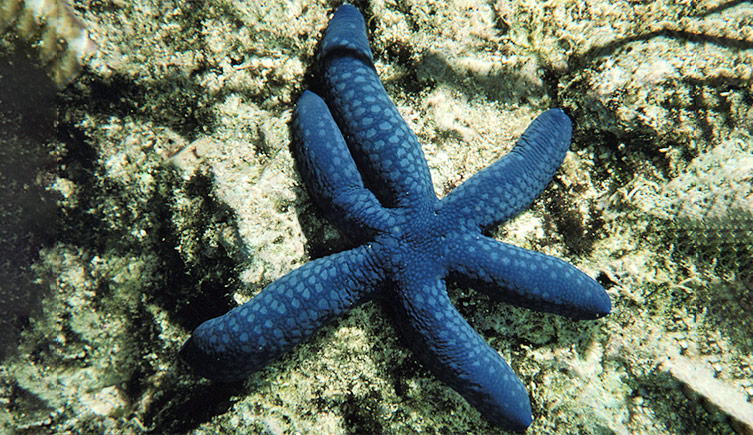At a glance
Record Linckia sea star colours and depth.
Type of activity: Outdoors and online
Who can take part? Divers and snorkellers
When? Any time
Where? Indo-West Pacific
How long will it take? 10 minutes per record

Blue morph of Linckia laevigata, Great Barrier Reef, Australia. © Suzanne Williams
Record Linckia sea star colours and depth.
Type of activity: Outdoors and online
Who can take part? Divers and snorkellers
When? Any time
Where? Indo-West Pacific
How long will it take? 10 minutes per record
This project has now finished. Thank-you to all who took part.
What makes a starfish blue? (or yellow, or grey or…?)
The iconic sea star Linckia laevigata is the ‘poster child’ for tropical reefs in the Indian and Pacific Oceans. It occurs as a variety of colours including yellow, orange, grey and purple but is best known for its royal-blue colour.
Blue pigments are extremely rare in the animal kingdom, and as a result this species is prized by the aquarium trade and is in the top ten most traded marine invertebrates. Given that 1.5–2 million people are thought to keep saltwater aquaria, this suggests a significant number of Linckia are harvested. These sea stars are also collected, dried and sold in tourist shops as holiday souvenirs.
We are interested in determining whether colour is genetically controlled and whether colour and habitat are related. In order to undertake such a study, we need to examine a large number of specimens. But specimens that have been removed from the sea lose their colour. This means we can only do this study using photos and we need lots of them!
You can contribute to this study by taking photos of Linckia laevigata and uploading them to our iNaturalist project. Please include:
Taking a photo of a living animal will do no damage to the animal if you handle them carefully and do not remove them from the water. If you do need to remove them from the water for a photo, take the photo quickly (make sure not to place the animal on a hot surface!) and return the animal carefully to the same site.
The data you collect will be used in a scientific study to look how differently coloured Linckia are distributed.
Photos do not have to be recent – so long as you can provide locality data – and ideally, depth and temperature. So this is the time to look through those holiday snaps that you’ve been meaning to sort!
Project page: Evolution of colour and vision in marine invertebrates


You can also upload photos on social media with hashtags like #betterinthesea or #prettyinthesea (highlighting the fact that Linckia lose their colour once dead) and #leaveonlyfootprints alongside #starfishselfie. We will track the use of these hashtags for our study.
Linckia laevigata are starfish (also known as sea stars) that live in tropical water in the Indian and West Pacific Oceans. They usually have five arms, but may also have four or six, and rarely seven.
They are commonly a vivid blue but may also occur in other colours (called colour morphs), eg yellow, orange, pink, grey, green-blue and light blue: see the images below.
Their arms are long and slender and have rounded, blunt tips.
The colour is uniform over one surface but may differ between top (aboral) and bottom (oral) surfaces. These surfaces do not have colour patterns and there are no nodules or lumps.
The animals are rigid to the touch and may seem to be dead or even not ‘real’, but they are just very slow moving.
If you are in the field, you can see the tiny, transparent tube feet that poke out through a groove that runs along the midline of the arms. These will withdraw quite quickly once the animal is disturbed.
Sometimes you may find them with their stomach everted through their mouth. They do this when they are feeding.
You may even see them spawning – they lift their bodies up off the ground, holding themselves up on the tips of their arms and release eggs or sperm into the water column from little, tiny pores in their skin. If you see an animal spawning do not disturb it but take its photo and include it in the database.
If you look at an animal very closely (or enlarge your photos) you may see circular clusters of these pores on the top (aboral) surface. From a distance these look like slightly darker circles on the skin.
The bottom (or oral) surface of the animal has small rectangular plates either side of the groove down the length of the arm.
These sea stars are not Linckia laevigata but are closely related and may be found in the same localities (see images below):